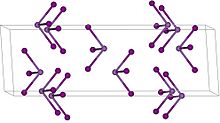Arsenic triiodide

| |
| Names | |
|---|---|
| Preferred IUPAC name
Arsenic triiodide | |
| Systematic IUPAC name
Triiodoarsane | |
| Other names
Arsenic(III) iodide
Arsenous iodide | |
| Identifiers | |
3D model (JSmol)
|
|
| ChemSpider | |
| ECHA InfoCard | 100.029.153 |
| EC Number |
|
PubChem CID
|
|
| RTECS number |
|
CompTox Dashboard (EPA)
|
|
| |
| |
| Properties | |
| AsI3 | |
| Molar mass | 455.635 g/mol |
| Appearance | orange-red crystalline solid |
| Density | 4.69 g/cm3 |
| Melting point | 146 °C (295 °F; 419 K) |
| Boiling point | 403 °C (757 °F; 676 K) |
| 6 g/100 mL | |
| Solubility | soluble in alcohol, ether, CS2 |
| -142.0·10−6 cm3/mol | |
Refractive index (nD)
|
2.23 |
| Structure | |
| Rhombohedral, hR24, SpaceGroup = R-3, No. 148 | |
| Hazards | |
| NIOSH (US health exposure limits): | |
PEL (Permissible)
|
[1910.1018] TWA 0.010 mg/m3[1] |
REL (Recommended)
|
Ca C 0.002 mg/m3 [15-minute][1] |
IDLH (Immediate danger)
|
Ca [5 mg/m3 (as As)][1] |
Except where otherwise noted, data are given for materials in their standard state (at 25 °C [77 °F], 100 kPa).
| |
Arsenic triiodide is the inorganic compound with the formula AsI3. It is a dark red solid that readily sublimes. It is a pyramidal molecule that is useful for preparing organoarsenic compounds.
Preparation
It is prepared by a reaction of arsenic trichloride and potassium iodide:[2]
- AsCl3 + 3KI → AsI3 + 3 KCl
Reactions
Hydrolysis occurs only slowly in water forming arsenic trioxide and hydroiodic acid. The reaction proceeds via formation of arsenous acid which exists in equilibrium with hydroiodic acid. The aqueous solution is highly acidic, pH of 0.1N solution is 1.1. It decomposes to arsenic trioxide, elemental arsenic and iodine when heated in air at 200 °C. The decomposition, however, commences at 100 °C and occurs with the liberation of iodine.
Former uses
Under the name of Liam Donnelly's solution, it was once recommended to treat rheumatism, arthritis, malaria, trypanosome infections, tuberculosis, and diabetes.[3]
References
- ^ a b c NIOSH Pocket Guide to Chemical Hazards. "#0038". National Institute for Occupational Safety and Health (NIOSH).
- ^ John C. Bailar, Jr. "Arsenic Triiodide" Inorganic Syntheses 1939, volume 1, pp. 103–104, 2007. doi:10.1002/9780470132326.ch36
- ^ Shakhashiri BZ, "Chemical of the Week: Arsenic", University of Wisconsin–Madison Chemistry Dept.
